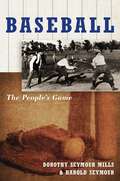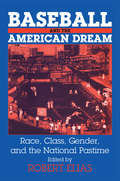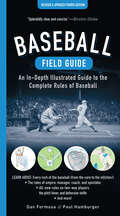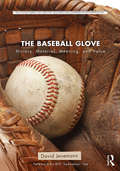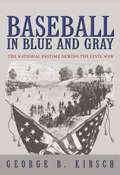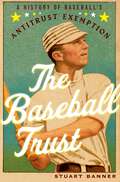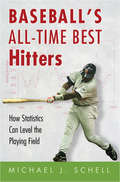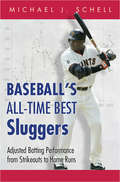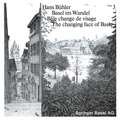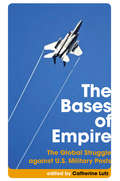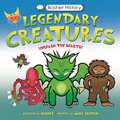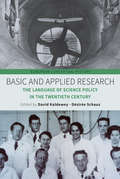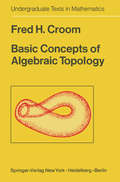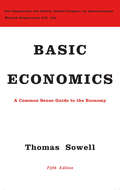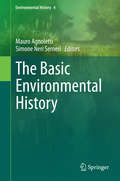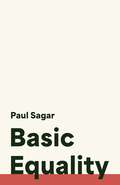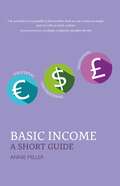- Table View
- List View
Baseball: The People's Game
by Harold Seymour Dorothy Seymour MillsIn Baseball: The People's Game, Dorothy Seymour Mills and Harold Seymour produce an authoritative, multi-volume chronicle of America's national pastime. The first two volumes of this study -The Early Years and The Golden Age -won universal acclaim. The New York Times wrote that they "will grip every American who has invested part of his youth and dreams in the sport," while The Boston Globe called them "irresistible." Now, in The People's Game, the authors offer the first book devoted entirely to the history of the game outside of the professional leagues, revealing how, from its early beginnings up to World War II, baseball truly became the great American pastime. They explore the bond between baseball and boys through the decades, the game's place in institutions from colleges to prisons to the armed forces, the rise of women's baseball that coincided with nineteenth century feminism, and the struggles of black players and clubs from the later years of slavery up to the Second World War. Whether discussing the birth of softball or the origins of the seventh inning stretch, the Seymours enrich their extensive research with fascinating details and entertaining anecdotes as well as a wealth of baseball experience. The People's Game brings to life the central role of baseball for generations of Americans. Note: On August 2, 2010, Oxford University Press made public that it would credit Dorothy Seymour Mills as co-author of the three baseball histories previously "authored" solely by her late husband, Harold Seymour. The Seymours collaborated on Baseball: The Early Years (1960), Baseball: The Golden Age (1971) and Baseball: The People's Game (1991).
Baseball: The People's Game
by Dorothy Seymour Mills Harold SeymourIn Baseball: The People's Game, Dorothy Seymour Mills and Harold Seymour produce an authoritative, multi-volume chronicle of America's national pastime. The first two volumes of this study -The Early Years and The Golden Age -won universal acclaim. The New York Times wrote that they "will grip every American who has invested part of his youth and dreams in the sport," while The Boston Globe called them "irresistible." Now, in The People's Game, the authors offer the first book devoted entirely to the history of the game outside of the professional leagues, revealing how, from its early beginnings up to World War II, baseball truly became the great American pastime. They explore the bond between baseball and boys through the decades, the game's place in institutions from colleges to prisons to the armed forces, the rise of women's baseball that coincided with nineteenth century feminism, and the struggles of black players and clubs from the later years of slavery up to the Second World War. Whether discussing the birth of softball or the origins of the seventh inning stretch, the Seymours enrich their extensive research with fascinating details and entertaining anecdotes as well as a wealth of baseball experience. The People's Game brings to life the central role of baseball for generations of Americans. Note: On August 2, 2010, Oxford University Press made public that it would credit Dorothy Seymour Mills as co-author of the three baseball histories previously "authored" solely by her late husband, Harold Seymour. The Seymours collaborated on Baseball: The Early Years (1960), Baseball: The Golden Age (1971) and Baseball: The People's Game (1991).
Baseball and the American Dream: Race, Class, Gender, and the National Pastime
by Robert EliasA fascinating look at how America's favorite sport has both reflected and shaped social, economic, and
Baseball and the American Dream: Race, Class, Gender, and the National Pastime
by Robert EliasA fascinating look at how America's favorite sport has both reflected and shaped social, economic, and
Baseball Field Guide, Fourth Edition: An In-Depth Illustrated Guide to the Complete Rules of Baseball
by Dan Formosa Paul HamburgerA great overview for novices and a precise reference guide for devoted fans!Admit it: Even if you&’re a die-hard fan of our national pastime, sometimes an umpire's call can be baffling. And for newer fans, Major League Baseball's nuanced rules—developed and revised over many decades—can be downright perplexing. Now updated throughout with the latest changes, including specifications about the universal designated hitter and limits on defensive shifts, the Baseball Field Guide lays out every rule in plain English. You&’ll learn to answer all these questions and more: Do you know the twenty-two ways a pitcher can be charged with a balk? Can you list all seven ways a batter can safely get to first base? Obstruction or interference—who&’s at fault when things get rough? What are the rules that apply before and after a game? What happens when spectators are the ones who misbehave? How well do you understand the infamous Infield Fly Rule (and why does it exist)? This is the clearest explanation anywhere of the rules of baseball. Designed for quick and intuitive searches, this entertaining reference will help you understand every aspect of the game and add to your enjoyment of the sport.
The Baseball Glove: History, Material, Meaning, and Value (Routledge Series for Creative Teaching and Learning in Anthropology)
by David JenemannThe baseball glove is a ubiquitous item, a crucial piece of equipment in the game of baseball, and it offers the opportunity to examine the production of material culture and social practice at numerous levels. Where and how is a glove made, and how does its manufacture square with the narratives surrounding its place in American cultural life? What are the myths, superstitions, and beliefs surrounding its acquisition, care, use, and significance? How does a glove function as the center of a web of cultural practices that illustrate how individuals relate to a consumer good as a symbol of memory, personal narrative, and national identity? How do the manufacturers of baseball gloves draw upon, promote, and in some sense create these practices? How do these practices and meanings change in other national and cultural contexts? The Baseball Glove offers students the opportunity to examine these questions in an engagingly written and illustrated book that promotes hands-on interaction with a quintessential item of material culture. At the same time, the book gives students the space for critical self-reflection about the place of material goods like sporting equipment in their lives, and it provides the chance to learn different methodological approaches to studying everyday objects.
The Baseball Glove: History, Material, Meaning, and Value (Routledge Series for Creative Teaching and Learning in Anthropology)
by David JenemannThe baseball glove is a ubiquitous item, a crucial piece of equipment in the game of baseball, and it offers the opportunity to examine the production of material culture and social practice at numerous levels. Where and how is a glove made, and how does its manufacture square with the narratives surrounding its place in American cultural life? What are the myths, superstitions, and beliefs surrounding its acquisition, care, use, and significance? How does a glove function as the center of a web of cultural practices that illustrate how individuals relate to a consumer good as a symbol of memory, personal narrative, and national identity? How do the manufacturers of baseball gloves draw upon, promote, and in some sense create these practices? How do these practices and meanings change in other national and cultural contexts? The Baseball Glove offers students the opportunity to examine these questions in an engagingly written and illustrated book that promotes hands-on interaction with a quintessential item of material culture. At the same time, the book gives students the space for critical self-reflection about the place of material goods like sporting equipment in their lives, and it provides the chance to learn different methodological approaches to studying everyday objects.
Baseball in Blue and Gray: The National Pastime during the Civil War
by George B. KirschDuring the Civil War, Americans from homefront to battlefront played baseball as never before. While soldiers slaughtered each other over the country's fate, players and fans struggled over the form of the national pastime. George Kirsch gives us a color commentary of the growth and transformation of baseball during the Civil War. He shows that the game was a vital part of the lives of many a soldier and civilian--and that baseball's popularity had everything to do with surging American nationalism. By 1860, baseball was poised to emerge as the American sport. Clubs in northeastern and a few southern cities played various forms of the game. Newspapers published statistics, and governing bodies set rules. But the Civil War years proved crucial in securing the game's place in the American heart. Soldiers with bats in their rucksacks spread baseball to training camps, war prisons, and even front lines. As nationalist fervor heightened, baseball became patriotic. Fans honored it with the title of national pastime. War metaphors were commonplace in sports reporting, and charity games were scheduled. Decades later, Union general Abner Doubleday would be credited (wrongly) with baseball's invention. The Civil War period also saw key developments in the sport itself, including the spread of the New York-style of play, the advent of revised pitching rules, and the growth of commercialism. Kirsch recounts vivid stories of great players and describes soldiers playing ball to relieve boredom. He introduces entrepreneurs who preached the gospel of baseball, boosted female attendance, and found new ways to make money. We witness bitterly contested championships that enthralled whole cities. We watch African Americans embracing baseball despite official exclusion. And we see legends spring from the pens of early sportswriters. Rich with anecdotes and surprising facts, this narrative of baseball's coming-of-age reveals the remarkable extent to which America's national pastime is bound up with the country's defining event.
Baseball in Blue and Gray: The National Pastime during the Civil War (PDF)
by George B. KirschDuring the Civil War, Americans from homefront to battlefront played baseball as never before. While soldiers slaughtered each other over the country's fate, players and fans struggled over the form of the national pastime. George Kirsch gives us a color commentary of the growth and transformation of baseball during the Civil War. He shows that the game was a vital part of the lives of many a soldier and civilian--and that baseball's popularity had everything to do with surging American nationalism. By 1860, baseball was poised to emerge as the American sport. Clubs in northeastern and a few southern cities played various forms of the game. Newspapers published statistics, and governing bodies set rules. But the Civil War years proved crucial in securing the game's place in the American heart. Soldiers with bats in their rucksacks spread baseball to training camps, war prisons, and even front lines. As nationalist fervor heightened, baseball became patriotic. Fans honored it with the title of national pastime. War metaphors were commonplace in sports reporting, and charity games were scheduled. Decades later, Union general Abner Doubleday would be credited (wrongly) with baseball's invention. The Civil War period also saw key developments in the sport itself, including the spread of the New York-style of play, the advent of revised pitching rules, and the growth of commercialism. Kirsch recounts vivid stories of great players and describes soldiers playing ball to relieve boredom. He introduces entrepreneurs who preached the gospel of baseball, boosted female attendance, and found new ways to make money. We witness bitterly contested championships that enthralled whole cities. We watch African Americans embracing baseball despite official exclusion. And we see legends spring from the pens of early sportswriters. Rich with anecdotes and surprising facts, this narrative of baseball's coming-of-age reveals the remarkable extent to which America's national pastime is bound up with the country's defining event.
The Baseball Trust: A History of Baseball's Antitrust Exemption
by Stuart BannerThe impact of antitrust law on sports is in the news all the time, especially when there is labor conflict between players and owners, or when a team wants to move to a new city. And if the majority of Americans have only the vaguest sense of what antitrust law is, most know one thing about it-that baseball is exempt. In The Baseball Trust, legal historian Stuart Banner illuminates the series of court rulings that resulted in one of the most curious features of our legal system-baseball's exemption from antitrust law. A serious baseball fan, Banner provides a thoroughly entertaining history of the game as seen through the prism of an extraordinary series of courtroom battles, ranging from 1890 to the present. The book looks at such pivotal cases as the 1922 Supreme Court case which held that federal antitrust laws did not apply to baseball; the 1972 Flood v. Kuhn decision that declared that baseball is exempt even from state antitrust laws; and several cases from the 1950s, one involving boxing and the other football, that made clear that the exemption is only for baseball, not for sports in general. Banner reveals that for all the well-documented foibles of major league owners, baseball has consistently received and followed antitrust advice from leading lawyers, shrewd legal advice that eventually won for baseball a protected legal status enjoyed by no other industry in America. As Banner tells this fascinating story, he also provides an important reminder of the path-dependent nature of the American legal system. At each step, judges and legislators made decisions that were perfectly sensible when considered one at a time, but that in total yielded an outcome-baseball's exemption from antitrust law-that makes no sense at all.
The Baseball Trust: A History of Baseball's Antitrust Exemption
by Stuart BannerThe impact of antitrust law on sports is in the news all the time, especially when there is labor conflict between players and owners, or when a team wants to move to a new city. And if the majority of Americans have only the vaguest sense of what antitrust law is, most know one thing about it-that baseball is exempt. In The Baseball Trust, legal historian Stuart Banner illuminates the series of court rulings that resulted in one of the most curious features of our legal system-baseball's exemption from antitrust law. A serious baseball fan, Banner provides a thoroughly entertaining history of the game as seen through the prism of an extraordinary series of courtroom battles, ranging from 1890 to the present. The book looks at such pivotal cases as the 1922 Supreme Court case which held that federal antitrust laws did not apply to baseball; the 1972 Flood v. Kuhn decision that declared that baseball is exempt even from state antitrust laws; and several cases from the 1950s, one involving boxing and the other football, that made clear that the exemption is only for baseball, not for sports in general. Banner reveals that for all the well-documented foibles of major league owners, baseball has consistently received and followed antitrust advice from leading lawyers, shrewd legal advice that eventually won for baseball a protected legal status enjoyed by no other industry in America. As Banner tells this fascinating story, he also provides an important reminder of the path-dependent nature of the American legal system. At each step, judges and legislators made decisions that were perfectly sensible when considered one at a time, but that in total yielded an outcome-baseball's exemption from antitrust law-that makes no sense at all.
Baseball's All-Time Best Hitters: How Statistics Can Level the Playing Field
by Michael J. SchellTony Gwynn is the greatest hitter in the history of baseball. That's the conclusion of this engaging and provocative analysis of baseball's all-time best hitters. Michael Schell challenges the traditional list of all-time hitters, which places Ty Cobb first, Gwynn 16th, and includes just 8 players whose prime came after 1960. Schell argues that the raw batting averages used as the list's basis should be adjusted to take into account that hitters played in different eras, with different rules, and in different ballparks. He makes those adjustments and produces a new list of the best 100 hitters that will spark debate among baseball fans and statisticians everywhere. Schell combines the two qualifications essential for a book like this. He is a professional statistician--applying his skills to cancer research--and he has an encyclopedic knowledge of baseball. He has wondered how to rank hitters since he was a boy growing up as a passionate Cincinnati Reds fan. Over the years, he has analyzed the most important factors, including the relative difficulty of hitting in different ballparks, the length of hitters' careers, the talent pool that players are drawn from, and changes in the game that raised or lowered major-league batting averages (the introduction of the designated hitter and changes in the height and location of the pitcher's mound, for example). Schell's study finally levels the playing field, giving new credit to hitters who played in adverse conditions and downgrading others who faced fewer obstacles. His final ranking of players differs dramatically from the traditional list. Gwynn, for example, bumps Cobb to 2nd place, Rod Carew rises from 28th to 3rd, Babe Ruth drops from 9th to 16th, and Willie Mays comes from off the list to rank 13th. Schell's list also gives relatively more credit to modern players, containing 39 whose best days were after 1960. Using a fun, conversational style, the book presents a feast of stories and statistics about players, ballparks, and teams--all arranged so that calculations can be skipped by general readers but consulted by statisticians eager to follow Schell's methods or introduce their students to such basic concepts as mean, histogram, standard deviation, p-value, and regression. Baseball's All-Time Best Hitters will shake up how baseball fans view the greatest heroes of America's national pastime.
Baseball's All-Time Best Hitters: How Statistics Can Level the Playing Field (pdf)
by Michael J. SchellTony Gwynn is the greatest hitter in the history of baseball. That's the conclusion of this engaging and provocative analysis of baseball's all-time best hitters. Michael Schell challenges the traditional list of all-time hitters, which places Ty Cobb first, Gwynn 16th, and includes just 8 players whose prime came after 1960. Schell argues that the raw batting averages used as the list's basis should be adjusted to take into account that hitters played in different eras, with different rules, and in different ballparks. He makes those adjustments and produces a new list of the best 100 hitters that will spark debate among baseball fans and statisticians everywhere. Schell combines the two qualifications essential for a book like this. He is a professional statistician--applying his skills to cancer research--and he has an encyclopedic knowledge of baseball. He has wondered how to rank hitters since he was a boy growing up as a passionate Cincinnati Reds fan. Over the years, he has analyzed the most important factors, including the relative difficulty of hitting in different ballparks, the length of hitters' careers, the talent pool that players are drawn from, and changes in the game that raised or lowered major-league batting averages (the introduction of the designated hitter and changes in the height and location of the pitcher's mound, for example). Schell's study finally levels the playing field, giving new credit to hitters who played in adverse conditions and downgrading others who faced fewer obstacles. His final ranking of players differs dramatically from the traditional list. Gwynn, for example, bumps Cobb to 2nd place, Rod Carew rises from 28th to 3rd, Babe Ruth drops from 9th to 16th, and Willie Mays comes from off the list to rank 13th. Schell's list also gives relatively more credit to modern players, containing 39 whose best days were after 1960. Using a fun, conversational style, the book presents a feast of stories and statistics about players, ballparks, and teams--all arranged so that calculations can be skipped by general readers but consulted by statisticians eager to follow Schell's methods or introduce their students to such basic concepts as mean, histogram, standard deviation, p-value, and regression. Baseball's All-Time Best Hitters will shake up how baseball fans view the greatest heroes of America's national pastime.
Baseball's All-Time Best Sluggers: Adjusted Batting Performance from Strikeouts to Home Runs (PDF)
by Michael J. SchellOver baseball history, which park has been the best for run scoring?1 Which player would lose the most home runs after adjustments for ballpark effect?2 Which player claims four of the top five places for best individual seasons ever played, based on all-around offensive performance.3 (See answers, below). These are only three of the intriguing questions Michael Schell addresses in Baseball's All-Time Best Sluggers, a lively examination of the game of baseball using the most sophisticated statistical tools available. The book provides an in-depth evaluation of every major offensive event in baseball history, and identifies the players with the 100 best seasons and most productive careers. For the first time ever, ballpark effects across baseball history are presented for doubles, triples, right- and left-handed home-run hitting, and strikeouts. The book culminates with a ranking of the game's best all-around batters. Using a brisk conversational style, Schell brings to the plate the two most important credentials essential to producing a book of this kind: an encyclopedic knowledge of baseball and a professional background in statistics. Building on the traditions of renowned baseball historians Pete Palmer and Bill James, he has analyzed the most important factors impacting the sport, including the relative difficulty of hitting in different ballparks, the length of hitters' careers, the talent pool from which players are drawn, player aging, and changes in the game that have raised or lowered major-league batting averages. Schell's book finally levels the playing field, giving new credit to hitters who played in adverse conditions, and downgrading others who faced fewer obstacles. It also provides rankings based on players' positions. For example, Derek Jeter ranks 295th out of 1,140 on the best batters list, but jumps to 103rd in the position-adjusted list, reflecting his offensive prowess among shortstops. Replete with dozens of never-before reported stories and statistics, Baseball's All-Time Best Sluggers will forever shape the way baseball fans view the greatest heroes of America's national pastime. Answers: 1. Coors Field 2. Mel Ott 3. Barry Bonds, 2001-2004 seasons
The Bases of Empire: The Global Struggle Against U.S. Military Posts (Transnational Institute)
by Catherine LutzThis book examines US military bases across the globe including those in Latin America, Europe, and Asia. It documents the massive political, economic and environmental impacts that these outposts have and studies the movements and campaigns against them.*BR**BR*US Military bases form a huge global system but are poorly understood by those not directly involved in their operation. The Pentagon is currently relocating many bases to fit with the strategies of pre-emption and resource control and this has intensified existing conflicts between the military and local people. The authors of this volume show how these seemingly local disputes are crucial to the success and failure of the American imperial project, and attempt to bring together the geographically scattered opposition movements to form a coherent campaign against the harmful effects of bases.*BR**BR*A key title for students of anthropology and politics, this collection will also open the eyes of US citizens to the damage the American empire causes in allied countries as well as in its war zones.
Basher History: Unleash the beasts! (Basher #139)
by Mary BudzikFrom the deepest, darkest depths of the Atlantic Ocean to the cacophonous canopies of the Amazon rainforest, Basher History: Legendary Creatures brings to life the weirdest, creepiest and most amazing beasts rumoured to have roamed our planet. Featuring well-known creatures like Bigfoot, Mermaids, and Vampires, Legendary Creatures invites you to journey to the forests of Uganda to discover the fierce Ndalawo, a leopard with a hyena-like cry, or to travel through Mayan ruins to meet the ominous Camazotz, a night-flying hybrid of man and bat. Basher’s distinctive, colourful illustrations bring these magical mythological beings to life, all the while keeping kids in-the-know about the diverse range of folklore across the world.For fans of mythical creatures, also check out Basher History: Myths and Legends and the rest of the Basher History series!
Basic and Applied Research: The Language of Science Policy in the Twentieth Century (European Conceptual History #4)
by David KaldeweyThe distinction between basic and applied research was central to twentieth-century science and policymaking, and if this framework has been contested in recent years, it nonetheless remains ubiquitous in both scientific and public discourse. Employing a transnational, diachronic perspective informed by historical semantics, this volume traces the conceptual history of the basic–applied distinction from the nineteenth century to today, taking stock of European developments alongside comparative case studies from the United States and China. It shows how an older dichotomy of pure and applied science was reconceived in response to rapid scientific progress and then further transformed by the geopolitical circumstances of the postwar era.
Basic and Applied Research: The Language of Science Policy in the Twentieth Century (European Conceptual History #4)
by David Kaldewey Désirée SchauzThe distinction between basic and applied research was central to twentieth-century science and policymaking, and if this framework has been contested in recent years, it nonetheless remains ubiquitous in both scientific and public discourse. Employing a transnational, diachronic perspective informed by historical semantics, this volume traces the conceptual history of the basic–applied distinction from the nineteenth century to today, taking stock of European developments alongside comparative case studies from the United States and China. It shows how an older dichotomy of pure and applied science was reconceived in response to rapid scientific progress and then further transformed by the geopolitical circumstances of the postwar era.
Basic and Clinical Immunology by Names: From the Biblical Time Until the Present
by Michael R. Shurin Galina V. Shurin Ken M. ShurinHundreds of eponyms are used within the field of immunology—Petri dish, Crohn’s disease, Bence Jones protein, Kupffer cells, Freund's adjuvant, Ouchterlony immunodiffusion, to name just a few—but most of us don't know much about the individuals who gave their names to these terms. Where were they born and educated, what other accomplishments are they credited with, why has history chosen to remember them, or not? This book presents the first comprehensive collection of immunologic eponyms, and through them tells the story of this fascinating field, from its earliest beginnings to present day. Organized by surname and meticulously cross-referenced and indexed, this book offers historical anecdotes and little-known facts which scientists, clinicians, students, and general readers will find captivating and memorable. A one-of-a-kind introduction to immunology that serves as both a history lesson and current reference on the diseases, treatments, and individuals who have been crucial to this field.
Basic Concepts of Algebraic Topology (Undergraduate Texts in Mathematics)
by F.H. CroomThis text is intended as a one semester introduction to algebraic topology at the undergraduate and beginning graduate levels. Basically, it covers simplicial homology theory, the fundamental group, covering spaces, the higher homotopy groups and introductory singular homology theory. The text follows a broad historical outline and uses the proofs of the discoverers of the important theorems when this is consistent with the elementary level of the course. This method of presentation is intended to reduce the abstract nature of algebraic topology to a level that is palatable for the beginning student and to provide motivation and cohesion that are often lacking in abstact treatments. The text emphasizes the geometric approach to algebraic topology and attempts to show the importance of topological concepts by applying them to problems of geometry and analysis. The prerequisites for this course are calculus at the sophomore level, a one semester introduction to the theory of groups, a one semester introduc tion to point-set topology and some familiarity with vector spaces. Outlines of the prerequisite material can be found in the appendices at the end of the text. It is suggested that the reader not spend time initially working on the appendices, but rather that he read from the beginning of the text, referring to the appendices as his memory needs refreshing. The text is designed for use by college juniors of normal intelligence and does not require "mathematical maturity" beyond the junior level.
Basic Economics: A Citizen's Guide To The Economy
by Thomas SowellThe bestselling citizen's guide to economicsBasic Economics is a citizen's guide to economics, written for those who want to understand how the economy works but have no interest in jargon or equations. Bestselling economist Thomas Sowell explains the general principles underlying different economic systems: capitalist, socialist, feudal, and so on. In readable language, he shows how to critique economic policies in terms of the incentives they create, rather than the goals they proclaim. With clear explanations of the entire field, from rent control and the rise and fall of businesses to the international balance of payments, this is the first book for anyone who wishes to understand how the economy functions. This fifth edition includes a new chapter explaining the reasons for large differences of wealth and income between nations. Drawing on lively examples from around the world and from centuries of history, Sowell explains basic economic principles for the general public in plain English.
The Basic Environmental History (Environmental History #4)
by Mauro Agnoletti Simone Neri SerneriThis book is an introductory instrument to the main themes of environmental history, illustrating its development over time, methodological implications, results achieved and those still under discussion. But the overriding aspiration is to show that the doubts, methods and knowledge elaborated by environmental history have a heuristic value that is far from negligible precisely in its attitude to the most consolidated major historiography. For this reason, this book gives an overview of environmental history as it is an essential component of the basic knowledge of global history. At the same time, it introduces specific aspects which are useful both for anyone wanting to deepen his/her studies of environmental historiography and for those interested in one of the many disciplinary areas – from rural history to urban history, from the history of technology to the history of public health, etc. with which environmental history develops a dialogue.
Basic Equality
by Paul SagarAn innovative argument that vindicates our normative commitment to basic equality, synthesising philosophy, history, and psychologyWhat makes human beings one another&’s equals? That we are "basic equals" has become a bedrock assumption in Western moral and political philosophy. And yet establishing why we ought to believe this claim has proved fiendishly difficult, floundering in the face of the many inequalities that characterise the human condition. In this provocative work, Paul Sagar offers a novel approach to explaining and justifying basic equality. Rather than attempting to find an independent foundation for basic equality, he argues, we should instead come to see our commitment to this idea as the result of the practice of treating others as equals. Moreover, he continues, it is not enough to grapple with the problem through philosophy alone—by just thinking very hard, in our armchairs; we must draw insights from history and psychology as well.Sagar writes that, as things stand, there appear to be no good arguments for believing in the truth of basic equality. Indeed, for much of Western intellectual history and social practice, basic inequality has been the default position. How is it then, Sagar asks, that in Western societies, in a period of less than a century, basic equality emerged as the dominant view? Sagar approaches this not as a mere philosophical puzzle, but as a dramatic historical development. In so doing, he shows us what is at stake when human beings treat one another as equals just because they are human beings.
